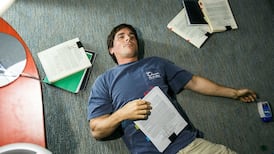Insta-Dublin has taken over. Today, Instagram traps and tourist traps are one and the same. From city to city, we see the same umbrellas hanging above laneways, the elaborate garnishes crowding bloody Marys, the vacuous slogans painted on hotel lobby walls, and the cheap neon signage.
In this current moment in Dublin, where the city’s character is literally being demolished, the chasing of nonsense design trends is an acute aspect of what pops up when something has been torn down.
What is the difference now between something being built specifically for Instagram - the Museum of Ice-cream in New York, San Francisco and Miami, the Museum of Selfies in Los Angeles - and, say the Dublin outpost of The Cauldron, a fantasy-wizard-themed bar that goes so far as to dispense cocktails from a unicorn head?
This stuff is geared towards a certain type of tourist, and the more the city builds things with solely that demographic in mind, the less Dublin feels like Dublin. Now, horses for courses, right? Does any of this really matter? Every city has its nonsense tourist-baiting activities; the Hard Rock cafes and the Madame Tussauds.
Dublin City Council should be focussed on three Cs for Dublin; community, character, culture
I suppose the thing about Dublin is that it’s a very small city. Larger cities can subsume this nonsense, and it can co-exist with the stuff that’s actually for people who live there. But Dublin can’t soak this up. Smaller cities thrive on character, and that’s why people visit them. Get rid of that, and you accidentally erase the thing people came for in the first place.
The tourist numbers in Dublin are staggering, but they’re nowhere near a level that could be reached, and the impact of businesses being built for tourists and deep-pocketed hospitality companies chasing that market, is a residue covering the capital.
Just under six million tourists visited Dublin last year, over five times the city’s population. 5:1. That’s the ratio of tourists to Dubliners over the course of a year. No wonder the city is gearing itself towards their needs.
Tourists dominating
Do we want to end up in a situation as acute as Barcelona, for example, where in 1990 the city had 1.7 million tourists and in 2018, 32 million? Do we want to end up like Reykjavik, where a population of 123,000 was crowded by a record 2.3 million tourists last year? In both of these cities, the dominance of tourists is creating huge discontent.
As Ruth McGowan, the director of the Dublin Fringe Festival said in this newspaper recently, "The city exists for people who live here, not just people who visit. You can build all the hotels you want, but if there is no culture, then you can't have those experiences where you travel and live like a local, because there's no local culture left."
Differentiating between “good” and “bad” gentrification may feel like a subjective game, but there are ideals upon which the city can develop sensibly, excel, and retain its heart. Dublin City Council should be focussed on three Cs for Dublin; community, character, culture.
It’s wishful thinking, maybe, but many people who live in Dublin voted for councillors who spoke about a vision for the city, such as the Greens, and the new Council will be watched closely.
We know the broader philosophies and behavioural science that both encompass and drive the ridiculous design we’re seeing in the city. The internet is today’s dominant cultural force, the self is at the centre of that, and the broadcasting of one’s interesting life to a busy, colourful backdrop isn’t confined to tourists, but also to a local giddy desire for gimmickry.
The descent continues for a city being designed for captions, propped up with scaffolding as rickety and temporary as an influencer busted for buying followers
Naturally, there are people who don’t exhibit such behaviour or taste, but they aren’t as easy to identify and would require a deeper mode of thought than “what will look good on Instagram?”
But what is designed as eclectic very quickly becomes generic. Much of Dublin’s contemporary design aesthetic appears to be presided over by a mildly insane and colourblind time-travelling aristocrat whose portals appear exclusively in car-boot sales made up of the spoils of bankrupt clowns and steampunk circus moguls with penchants for mid-century furniture.
Kyle Chyka’s important article for The Verge three years ago - Welcome to AirSpace: How Silicon Valley helps spread the same sterile aesthetic across the world - cleverly articulated the “harmonisation of tastes” that “creates you going to the same place all over again” no matter what city you’re in.
Rosita Boland's article last week on the opening of the Marlin Hotel in Dublin, tapped into this phenomenon, "The overall effect is very like what you'd imagine communal living spaces to look like," she wrote of the new hotel, "Or perhaps not that far off the concept behind the open-plan office spaces of some of the world's most famous social-media offices." This is AirSpace, cluttered.
The fact that this sort of design is bragged about (“Another Instagram moment,” The Marlin’s marketing manager told Boland, showing her around) and that those who replicate it, chasing empty trends, aren’t actively embarrassed about what they’ve just presided over design-wise, goes to show how far into the maze we have ventured.
Will Dublin be able to find its way out? Past the stuffed animal heads on walls and unused boardgames on shelves? Beyond the mismatched furniture and Pinterest boards come to life? Over the fishbowl glasses and barmen dressed like chimney sweeps? Under the knock-off Eames chairs and meals in skillets?
Turn on the smoke machine! Polish the mirrors! The descent continues for a city being designed for captions, propped up with scaffolding as rickety and temporary as an influencer busted for buying followers. None of this will last, and it certainly isn’t being built to.










